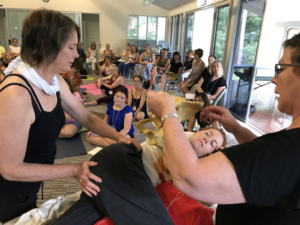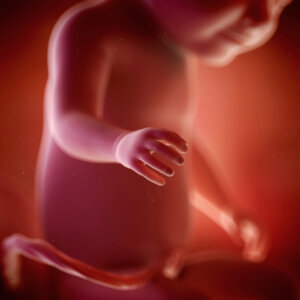 Between now and 32 weeks, most babies turn so they are head-down and bottom-up. By 34 weeks, your care provider expects baby to be head-down. That’s because once baby’s head is heavy enough, gravity brings it down into a symmetrical womb.
Between now and 32 weeks, most babies turn so they are head-down and bottom-up. By 34 weeks, your care provider expects baby to be head-down. That’s because once baby’s head is heavy enough, gravity brings it down into a symmetrical womb.
Some babies stay bottom-down (breech) or sideways (transverse). But why is that? Sometimes a placenta is below the baby, blocking baby from getting head-down. Often, there is a simple need for balance — the first principle of Spinning Babies®. Uterine ligaments and muscles may be either too tight, asymmetrical (twisted or torqued), or too loose. The SI joints or the symphysis pubis may be out of alignment, as well.
This is not your fault. We simply live in an era where a slight twist in the pelvis is common. Think of those repetitive actions like pressing the gas pedal, crossing your legs, or carrying a toddler on your hip. Pelvic asymmetry could also be caused by a sports injury or a sudden stop from a fender bender.
Don’t worry! You can work to align the pelvis and relax tight uterine ligaments. Start by finding a Chiropractor who knows the Webster Technique and who specializes in working with pregnant people. Even better if the chiropractor or bodyworker is a Spinning Babies® Aware Practitioner (your can find one near you in our searchable directory here).
Regarding breech, some doctors don’t make suggestions for turning a breech until 36 weeks since many babies turn on their own. Frankly, many providers don’t realize that body balancing gives baby an increased chance of turning on their own. For this reason, we’ve put together a handy 6-day program for parents who are 30 weeks pregnant or more with a breech baby. We find it is easier for babies to turn now because there is a higher water-to-baby ratio than in future weeks.
Gentle jiggling activates the fascia (connective tissue) to relax muscle structure when done gently and pervasively. We call it, Shake the Apples. Hold the upper thigh in two hands and then the buttock and hip between the hands. Create a vibration between the hands by jiggling (as in jello jiggling!). Don’t really shake — that’s too jerky or strong. Jiggle for at least three minutes on each side, with each of you changing positions to rest or reach comfortably.


Baby now weighs about 3 pounds and measures between 16 and 17 inches long. Baby uses all five senses now, too, even being able to detect some light through your belly!

As magical as this time can be, let’s be real about what you could do without: swollen feet, fatigue, and headaches. These aren’t uncommon, thanks to increased blood flow and hormones. Ease swelling with additional protein (80-100 grams a day or 120 grams with twins) and boost circulation by walking about 30 minutes a day. Though it’s tempting to go-go-go before baby’s arrival, rest daily — even if it’s just for 10 minutes. Combat both fatigue and headaches by staying hydrated with water while ditching caffeine and soda.
Affirmations are short, powerful statements that can affect your conscious thoughts. Close your eyes, breathe deeply and slowly, and repeat the following to yourself each day throughout the next week. Fill yourself with breath and feel the joy:
For additional education to even further enhance your pregnancy and labor preparation, shop our extensive collection of digital downloads, videos, DVDs, workbooks, and more.
One of our most beloved products, now with subtitles in English, French, and Spanish, offering expert support to reduce intervention and increase comfort throughout pregnancy and birth.